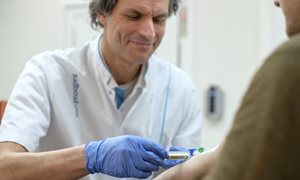
A tooth with a cavity, cleaned by hand and filled with a biological filling agent, is no worse than a tooth whose cavity has been repared by drill and fitted with a conventional filling. That's according to a recently published review article by retired dental researcher Jo Frencken of Radboud university medical center. “Many still associate this method with developmental work. But for many situations there is no difference from the gold standard: by drill.”
ART (atraumatic restorative treatment) is a method from the mind of Jo Frencken, who until 2015 was a dentist, researcher and associate professor in the Department of Dentistry at Radboud university medical center. It is a dental treatment approach for preventing and controlling cavities. The major difference is in the method: to clean the cavity, the dentist does not use a drill, but a small scoop. The filling material used is also different: it is biological and contains no toxic components.
Frencken devised the technique around 1985, when he was doing development work in Tanzania. “Often there was no electricity for the dental drill, and no amalgam for the fillings was available”, says Frencken. He and his colleagues were forced to clean cavities with hand instruments. To do this, they used a self-adhesive filling material: a so-called glass ionomer cement.
No difference from the gold standard
Since then, ART has gradually developed into a fully-fledged dental technique, and researchers around the world have been examining all aspects of ART - the mechanics, materials, instruments to be used, quality, acceptance and costs. It turns out that the technique is not inferior to drilling and filling with conventional materials, unless the cavities are large, hard to reach or very small, where you can't reach with a dental scoop.
That there is no difference in the quality of fillings is also shown by the most recent review article (meta-analysis) that Frencken and colleagues recently published in British Dental Journal . They focused on studies that compared ART fillings made from glass ionomer cement with conventional fillings: the old-fashioned dark amalgam fillings, based on metal, and the more recent light composite fillings, which consist of a synthetic resin. From English, Portuguese, Spanish, Indian and Chinese datasets, the authors compared data from more than 2,000 filled deciduous molars and more than 6,000 permanent molars. “For fillings in the chewing surfaces of deciduous and permanent molars and in surfaces of deciduous molars that contact each other, we found no significant difference between ART fillings and conventional fillings”, says Frencken.
Dental care outside the practice
Those results are increasingly opening the door of the treatment room to ART. “There are substantial advantages”, says Frencken. “With ART, you don't use a drill, so you can provide dental care outside the practice. Moreover, treatment without a drill is less painful, and anesthesia is often not even necessary. ART is therefore a godsend for children, the elderly, people with disabilities: in fact, even for everyone.” An additional advantage in this day and age is the absence of splashing water around to cool the drill head. “With ART, you don't use an air or water blower. Thus, saliva from the patient does not float around in the chamber, with the risk of transmission of, for example, the coronavirus, but stays in the patient's mouth.”
In addition, the filling made of glass ionomer cement is not harmful to the environment and health, unlike typical fillings. “The dark amalgam fillings are partly made up of mercury, a metal that is harmful in its free form.” Along with the rest of the world, Dutch dentists therefore banned amalgam from the dental chair. The newer white fillings made of synthetic resin did not solve that problem, says Frencken. “When people die and are buried, both types of fillings don't break down. And with cremation, the toxins end up in the environment with the smoke.”
ART in education
Despite all the advantages, support for ART is still lacking among Dutch dentists. “Many of them still associate the technique with development work”, says Frencken. “They still see it as a kind of stopgap measure, not a full-fledged method.” This is also reflected in a 2015 survey: less than half of Dutch dentists, 43 percent, use ART when necessary. Yet there is good news: ten years earlier, that support was even lower at 26 percent. So there does seem to be a turnaround.
But the really big steps toward seeing ART as a fully-fledged treatment method in Dutch dental practices need to be taken in education, Frencken thinks. “What dentists don't learn during their studies doesn't stick as well. This also applies to ART. The threshold for dentists to immerse themselves in new methods is high. You can only break that by including ART in dental education.” Until then, Frencken continues to see it as his job to continue to raise awareness of ART, even though he has been retired for six years. “I continue to see it as my job to take stock once in a while of studies that have been published. The counter stands at 675.”
About the publicatie in British Dental Journal
Survival estimates of atraumatic restorative treatment versus traditional restorative treatment: a systematic review with meta-analyses – Jo E Frencken, Shanshan Liang, Qian Zhang. DOI: 10.1038/s41415-021-2701-0.
-
Want to know more about these subjects? Click on the buttons below for more news.
More information
Pauline Dekhuijzen

wetenschaps- en persvoorlichter






